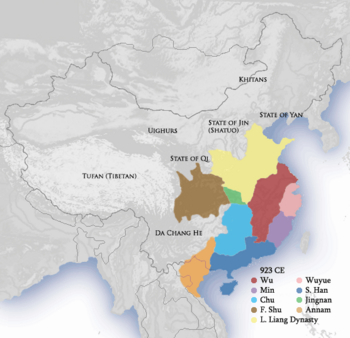Southern Han facts for kids
Quick facts for kids
Han / Yue
|
|||||||||||
|---|---|---|---|---|---|---|---|---|---|---|---|
| 917–971 | |||||||||||

Southern Han (dark blue)
|
|||||||||||
| Capital | Xingwang Fu (Guangzhou) | ||||||||||
| Common languages | Middle Chinese | ||||||||||
| Government | Monarchy | ||||||||||
| Emperor | |||||||||||
|
• 917–941
|
Emperor Gaozu | ||||||||||
|
• 941–943
|
Emperor Shangdi | ||||||||||
|
• 943–958
|
Emperor Zhongzong | ||||||||||
| Historical era | Five Dynasties and Ten Kingdoms Period | ||||||||||
|
• Established
|
917 | ||||||||||
|
• Renamed from "Yue" to "Han"
|
918 | ||||||||||
|
• Ended by the Song dynasty
|
971 | ||||||||||
|
|||||||||||
| Today part of | China Vietnam |
||||||||||
| Southern Han | |||||||||||||
|---|---|---|---|---|---|---|---|---|---|---|---|---|---|
| Traditional Chinese | 南漢 | ||||||||||||
| Simplified Chinese | 南汉 | ||||||||||||
| Literal meaning | South Han | ||||||||||||
|
|||||||||||||
The Southern Han (Chinese: 南漢; Mandarin Pinyin: Nán Hàn; Jyutping: Naam4 Hon3) was a kingdom in southern China. It existed from 917 to 971 AD. It was one of the many smaller states during a time called the Five Dynasties and Ten Kingdoms period. This was a period when China was divided into many different kingdoms.
The Southern Han kingdom was first called "Yue." It was later renamed "Han." It was located along China's southern coast. Today, this area includes Guangdong and Guangxi provinces. Its capital city was Xingwang Fu, which is now Guangzhou. The Southern Han tried to take over a nearby area controlled by the Vietnamese, but they were not successful.
Contents
How the Southern Han Kingdom Began
The story of Southern Han starts with a man named Liu Yin. In 905, the Tang dynasty government made him a regional governor. The Tang dynasty was a powerful empire that ruled China before this period.
Two years later, the Tang dynasty fell apart. Many leaders in southern China started their own kingdoms. However, Liu Yin did not immediately declare himself a king. He simply took the title of Prince of Nanping in 909.
Liu Yan Founds the Kingdom
After Liu Yin died in 917, his brother, Liu Yan, took over. Liu Yan decided to create a new kingdom. He first named it "Yue."
In 918, Liu Yan changed the kingdom's name to "Han." He did this because his family name, Liu, was the same as the ruling family of the famous Han dynasty. He claimed to be a descendant of that ancient and powerful dynasty. Because of this, his kingdom is known as the Southern Han dynasty.
Where the Southern Han Kingdom Was
The capital city of Southern Han was in Guangzhou. The kingdom's lands stretched along the coast. This included areas that are now Guangdong, Guangxi, and the island of Hainan.
The Southern Han shared borders with other kingdoms. These included Min, Chu, and the Southern Tang. It also bordered the non-Chinese kingdom of Dali. After the Southern Tang conquered Min and Chu, they became the main neighbor to the north of Southern Han.
Wars with the Vietnamese

Towards the end of the 800s, the Tang dynasty became weak. Local Vietnamese leaders began to take control of their own lands in northern Vietnam. This area was called Jinghai.
The Southern Han kingdom tried twice to conquer these Vietnamese territories. They launched campaigns in 931 and again in 938. The second battle, known as the Battle of Bạch Đằng, was a major defeat for the Southern Han. Both attempts to expand into Vietnam failed.
The End of the Southern Han Kingdom
The period of the Five Dynasties and Ten Kingdoms ended in 960. This is when the Song dynasty was founded. The Song dynasty replaced the Later Zhou dynasty.
The new Song rulers wanted to reunite all of China. They began to expand their power in the south. Throughout the 960s and 970s, the Song dynasty grew stronger. Finally, in 971, the Song dynasty forced the Southern Han kingdom to surrender. This brought an end to the Southern Han dynasty.
Rulers of Southern Han
The Southern Han kingdom had four main rulers during its existence. Here is a list of them:
| Temple Names | Posthumous Names | Personal Names | Years Ruled | Era Names |
|---|---|---|---|---|
| Gao Zu (高祖 gāo zǔ) | Tian Huang Da Di (天皇大帝 tiān huáng dà dì) | Liu Yan (劉巖 liú yán)
Liu Yan (劉龑 liú yǎn) after 926 |
917–941 | Qianheng (乾亨 qián hēng) 917–925 Bailong (白龍 bái lóng) 925–928 |
| Did not exist | Shang Di (殤帝 shāng dì) | Liu Bin (劉玢 liú bīn) | 941–943 | Guangtian (光天 guāng tiān) 941–943 |
| Zhong Zong (中宗 zhōng zōng) | Wénwǔ Guāngmíng Xiào (文武光明孝皇帝)
Too tedious thus not used when referring to this sovereign |
Liu Sheng (劉晟 liú shèng) | 943–958 | Yingqian (應乾 yìng qián) 943 Qianhe (乾和 qiàn hé) 943–958 |
| Hou Zhu (後主 hòu zhǔ) | Did not exist | Liu Chang (劉鋹 liú chǎng) | 958–971 | Dabao (大寶 dà bǎo) 958–971 |
Rulers Family Tree
| Southern Han rulers family tree | ||||||||||||||||||||||||||||||||||||||||||||||||||||||||||||||||||||||||||||||||||||||||||||||||||||||||||||||||||||||||||||||||||||||||||||||||||||||||||||||||||||||||||||||||||||||||||||||||||||||||||||||||||||||||||||||||||||||||||||||||||||||||||||||||||||||||||||||||||||||||||||||||||||||||||||||||||||||||||||||||||||||||||||||||||||||||||||||||||||
|---|---|---|---|---|---|---|---|---|---|---|---|---|---|---|---|---|---|---|---|---|---|---|---|---|---|---|---|---|---|---|---|---|---|---|---|---|---|---|---|---|---|---|---|---|---|---|---|---|---|---|---|---|---|---|---|---|---|---|---|---|---|---|---|---|---|---|---|---|---|---|---|---|---|---|---|---|---|---|---|---|---|---|---|---|---|---|---|---|---|---|---|---|---|---|---|---|---|---|---|---|---|---|---|---|---|---|---|---|---|---|---|---|---|---|---|---|---|---|---|---|---|---|---|---|---|---|---|---|---|---|---|---|---|---|---|---|---|---|---|---|---|---|---|---|---|---|---|---|---|---|---|---|---|---|---|---|---|---|---|---|---|---|---|---|---|---|---|---|---|---|---|---|---|---|---|---|---|---|---|---|---|---|---|---|---|---|---|---|---|---|---|---|---|---|---|---|---|---|---|---|---|---|---|---|---|---|---|---|---|---|---|---|---|---|---|---|---|---|---|---|---|---|---|---|---|---|---|---|---|---|---|---|---|---|---|---|---|---|---|---|---|---|---|---|---|---|---|---|---|---|---|---|---|---|---|---|---|---|---|---|---|---|---|---|---|---|---|---|---|---|---|---|---|---|---|---|---|---|---|---|---|---|---|---|---|---|---|---|---|---|---|---|---|---|---|---|---|---|---|---|---|---|---|---|---|---|---|---|---|---|---|---|---|---|---|---|---|---|---|---|---|---|---|---|---|---|---|---|---|---|---|---|---|---|---|---|---|---|---|---|---|---|---|---|---|---|---|---|---|---|---|---|---|---|---|---|
|
||||||||||||||||||||||||||||||||||||||||||||||||||||||||||||||||||||||||||||||||||||||||||||||||||||||||||||||||||||||||||||||||||||||||||||||||||||||||||||||||||||||||||||||||||||||||||||||||||||||||||||||||||||||||||||||||||||||||||||||||||||||||||||||||||||||||||||||||||||||||||||||||||||||||||||||||||||||||||||||||||||||||||||||||||||||||||||||||||||

